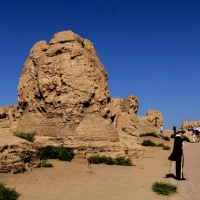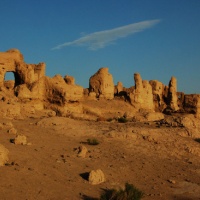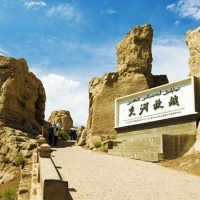Jiaohe Ruins
Jiaohe Ancient City Ruins, Turpan The ancient city of Jiaohe, located at 10km (6mi) west of Turpan in the Xinjiang Uygur Autonomous Region, was built with rammed earth and bricks 2 300 years ago. The city, situated along the Silk Road, was of great military significance and played a pivotal role in the economic development of Western and Eastern countries.
The ancient Jiaohe city dates from the Han to Uighur times, a period of about 1500 years, nominally from the 1st century BC through the 14th century AD. It was the capital of Jushi(Cheshi) kingdom during Han, then a Gaochang commandery (4c - 6c AD), then a Tang county seat (from 640 AD), gradually declining after the Uighur takeover (10th century). Jiaohe city was finally abandoned after its destruction during an invasion by the Mongols led by Genghis Khan in the 13th century. 
Since it declines, what was left of Jiaohe city has steadily deteriorated. The Jiaohe Ruins is the site of ancient Chinese ruins found in the Yarnaz Valley, 10 km west of the city of Turfan, Xinjiang province, China. The desert Jiaohe site is roughly 1700m (1 mile) east to west, and 300m (1000 ft) wide north to south. The view here looks east, more or less from the center of the site.
In Jiaohe ruins, some cultural relic or remains like mural paintings were left withrammed earth and bricks. This rich treasury of mural paintings suggests that the ancient Huihu painters used techniques similar to those used in the Dun-huang mural paintings.  Featuring sedate and graceful Buddhas and bodhisattvas, strong and resolute lokapalas and guardians, they are primarily vehicles for religious ideas. But they also present images of kings and queens and people from all levels of society in the ancient Huihu Kingdom, as well as portraying the way of life of the Uygur people in ancient times.
Featuring sedate and graceful Buddhas and bodhisattvas, strong and resolute lokapalas and guardians, they are primarily vehicles for religious ideas. But they also present images of kings and queens and people from all levels of society in the ancient Huihu Kingdom, as well as portraying the way of life of the Uygur people in ancient times.
At present, natural forces threaten the site: erosion by gale force winds which blow dust and sand against the walls and fill the streets and courtyards with sand. Erosion of the cliffs by floodwater, threatening them with collapse, is the most serious and urgent threat to the ruins. Both the Nara National Cultural Properties Research Institute and the Xinjiang Cultural Relics Bureau have been cooperating in a joint venture to preserve the ruins of the site since 1992.

